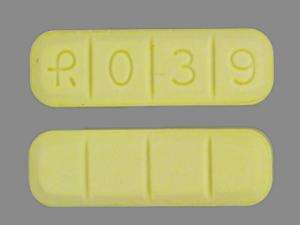R039 Xanax Alprazolam (Alprazolam), is an anti-anxiety medication in the benzodiazepine drug family, the same family that includes diazepam (Valium), clonazepam (Klonopin), lorazepam (Ativan), flurazepam (Dalmane), and others. The FDA approved alprazolam in October 1981 and it has become one of the most widely prescribed benzodiazepines for the treatment of generalized anxiety disorder and panic disorder. According to the Substance Abuse and Mental Health Services Administration, benzos help send 60,000 people per year to publicly-funded rehab centers. Add in the privately funded centers and the number would be even higher. The number of people being admitted to drug rehabs for addictions involving benzodiazepines nearly tripled in the last 10 years.
Over time, using or abusing R039 Xanax will build up a tolerance to the drug. Tolerance often goes hand-in-hand with the development of physical dependence. As the user takes increasingly higher doses to achieve the same effect as before their brain may more quickly begin to rely on the drug to function normally. If a dependent user tries to quit taking the drug, he or she will likely experience withdrawal effects as the body and brain adjust to living without the drug. The experience of Xanax detoxification (R09 Xanax detox) and withdrawal is usually unpleasant, but is a necessary step that paves the way for long-term healing.
R039 Xanax has a very short half-life, meaning that it enters and exits the body faster than other benzodiazepines so the rapid removal of the drug can be harmful to both the body and brain. Cold-turkey withdrawal can lead to severe reactions, such as seizures. Xanax withdrawal seizures can be, in some cases, fatal.
While there are few recorded cases of death from benzodiazepine withdrawal, they do exist. Deciding to quit the drug cold-turkey with no medical assistance can mean serious consequences, including death. A sudden loss of chemicals can shock the brain and send it into a panic. Medical professionals recommend tapering off the drug to avoid a potentially fatal shock. The recommended method is to reduce intake of the drug by particular increments. It is best to consult with a physician on this matter as they will be able to help calculate the proper dosage reduction.
Physical Withdrawal Symptoms
Physical R039 Xanax withdrawal symptoms may include:
Sweating or excessive perspiration
Tremors or shaking (particularly in the hands)
Convulsions or seizures
Sore, stiff muscles
Muscle spasms or twitches
Nausea and vomiting
Diarrhea or soft stool
Headache
Weight loss or weight gain
Heart palpitations or tachycardia
For women: Increased menstrual bleeding, breast tenderness and menstrual cramping
Psychological Withdrawal Symptoms
In addition to physical side effects, Xanax withdrawal symptoms can be psychological as well, including:
Insomnia or restless sleep
Nervousness or tension
Confusion or depression
Irritability
Paranoia and fear
Anxiety and panic
Withdrawing from family and friends
Heightened senses (e.g. noises seem louder, lights seem brighter)
These symptoms of R039 bar detoxification and withdrawal are sometimes referred to as benzodiazepine withdrawal syndrome. There is a progression of symptoms, from anxiety and insomnia to flu-like experiences, to a return of the psychological experience present before treatment with the drug. The severity of the withdrawal experience varies greatly in accordance with the amount of the drug a person was taking prior to detoxification. It is best to taper off of Xanax to avoid serious complications.
While withdrawal symptoms can occur for individuals who are taking Xanax exactly as their physician prescribed, it is much more common for people who are misusing or addicted to the medication to experience adverse effects.





